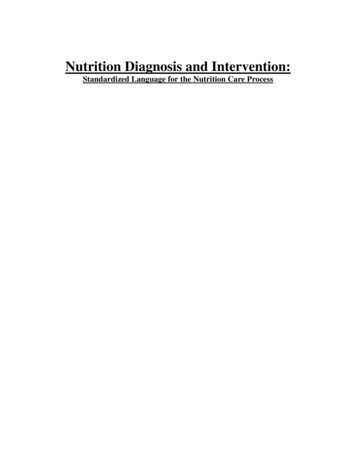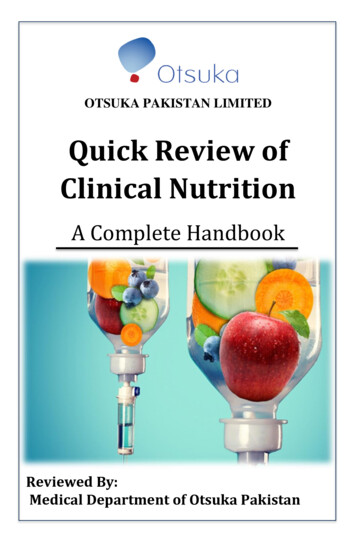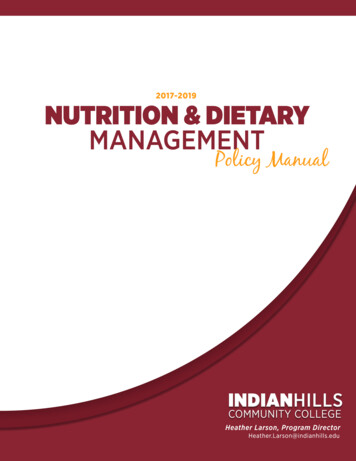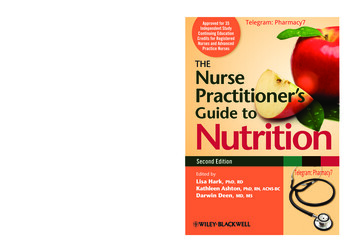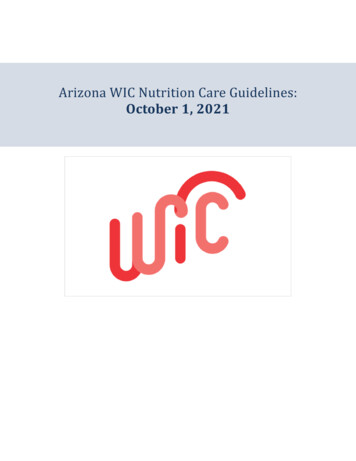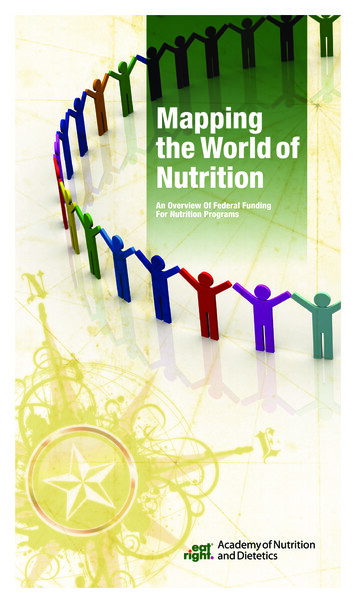
Transcription
mappingthe World ofNutritionAn Overview Of Federal FundingFor Nutrition Programs
The Academy of Nutritionand DieteticsThe Academy of Nutrition and Dietetics is the world’slargest organization of food and nutrition professionals with over 75,000 members.The Academy is committed to improving the nation’s health and advancing theprofession of dietetics through research, education and advocacy.Public policy and advocacy are core functions of the Academy and are critical toachieving its mission – empowering its members to be the nation’s food and nutritionleaders – and its vision – optimizing the nation’s health through food and nutrition.The Academy of Nutrition and Dietetics’ legislative and public policy priorities focuson two issue areas:Consumer and Community Issues Prevention and treatment of chronic disease, including health care equity Meeting nutrition needs through the life cycle: Maternal and child nutritionto healthy aging Quality food and nutrition through education, production, access and delivery Nutrition monitoring and researchProfessional Issues Consumer Protection and Licensure: Protection of the Public Workforce demand: Assuring the Public has access to nutrition servicesdelivered by qualified practitioners Outcome-driven nutrition services in changing health systemsThis map has been developed to give a better understanding of the federal publicpolicy issues that will help us meet our commitment to improving the nation’s health.For more information about the Academy of Nutrition and Dietetics’ public policyefforts, visit our website: Eatright.org.
Richard B. RussellNational School Lunch Act(2010 Healthy Hunger-Free Kids Act)Reauthorized next in 2015C o m m i tteew i t hJ u r i s d i ct i onSENATE Committee on Agriculture, Nutrition andForestry; Subcommittee on Nutrition, SpecialtyCrops, Food and Agriculture ResearchF ede r a lHOUSE Education and the WorkforceCommittee; Subcommittee on Early ChildhoodElementary and Secondary EducationO v e r s i g h tUS Department of Agriculture (USDA) – Food and Nutrition Service (FNS)p r o g r a m sNational School Lunch ProgramSummer Food Service Programfede r a l 11.02 billionChild and Adult CareFood Program (CACFP)fund i n g 423.5 million**** 2.9 billion**s take h o l de r s Farmers/Producers Hunger, poverty, public health, senior, and children’s advocates Farm-to-institution advocates School nutrition services Childcare providers and centers Summer camps State: Departments of Health, Human Services, Agriculture, or Education Regional Food and Nutrition Service (FNS) office Local: School districts, government agencies, camps, or school healthprivate/non-profit organizations Participants (below)pa r t i c i pant s30.6 million total students; 21.5million (70.5%)* of these studentsqualify for free or reduced-price meals.**2.4 million children under 18*and people with mental or physicaldisabilities over 18 who participatein school programs (based on Julypeak participation).*3.6 million children and adults*attending child and adult day carecenters, family child care homes,after school programs, and homelessshelters; 81.7% which qualify for freeor reduced-price meals.***FY 2013 Data ** Note: Household incomes at or below 130 percent of the poverty level are eligible for free meals; household incomes between 130 percentand 185 percent of the poverty level are eligible for reduced-price meals3
Child Nutrition Act of 1966Title III (2010 Healthy Hunger-Free Kids Act)Reauthorized next in 2015C o m m i tteew i t hJ u r i s d i ct i onSENATE Committee on Agriculture, Nutrition andForestry – Subcommittee on Nutrition, SpecialtyCrops, Food and Agriculture ResearchF ede r a lHOUSE Education and the WorkforceCommittee – Subcommittee on Early ChildhoodElementary and Secondary EducationO v e r s i g h tU.S. Department of Agriculture (USDA) – Food and Nutrition Service (FNS)p r o g r a m sFresh Fruit andVegetable SnackProgramWIC Farmers’Market NutritionProgramSpecialSupplemental FoodProgram forWomen, Infantsand Children (WIC)fede r a l 165.5 millionSchool BreakfastProgramfund i n g 6.49 billion 16.5 millionSpecial MilkProgram 10.6 million 3.5 billions take h o l de r s Farmers/Producers Grocers Hunger, poverty, public health, and children’s advocates Lactation advocates Farmers’ market groups Fresh produce advocates Farm-to-institution advocates School nutrition services Local: Schools, WIC agencies State: Departments of Health, Agriculture, or Education;Indian Tribal Organizations Participants (below)pa r t i c i pant sOver 4 millionchildren at selectedschools that have atleast 50% populationthat qualifies for free andreduced-price meal***1.7 million women,infants, andchildren enrolled inthe WIC program**8.6 million pregnantand post-partumwomen, infants andchildren with familyincome less than 185%of Federal PovertyIncome Guidelines(FPIG), and judged tobe nutritionally at-risk***Children inschools, child careinstitutions andeligible camps that donot participate in otherFederal child nutritionmeal service programs(4700 outlets served54.4 million half pints)**** Note: Household incomes at or below 130 percent of the Federal Poverty Income Guidelines (FPIG) are eligible for free meals;household incomes between 130 percent and 185 percent of the FPIG are eligible for reduced-price meals**FY 2012 Data***FY 2013 Data13.15 millionstudents total; 11.1million (85%***) ofthese students qualifyfor free or reduced-pricemeals (see note)*4
Agricultural Act of 2014 (Farm Bill)Reauthorized next in 2018C o m m i tteew i t hSENATE Committee on Agriculture, Nutrition andForestry – Subcommittee on Nutrition, SpecialtyCrops, Food and Agricultural ResearchF ede r a lJ u r i s d i ct i onHOUSE Agriculture Committee –Subcommittee on Department Operations,Oversight and NutritionO v e r s i g h tU.S. Department of Agriculture (USDA) – Food and Nutrition Service (FNS)p r o g r a m ditySupplementalFood m –Education(SNAP-Ed)fede r a l 202.9 million** 79 billion* 285 million***Food DistributionProgram on IndianReservations(FDPIR)Senior Farmers’Market NutritionProgram(SFMNP)The EmergencyFood AssistanceProgram(TEFAP) 20 million** 688.1 million†fund i n g 99.7 million**s take h o l de r s Farmers/Producers Farmers/Producers Farmers/Producers Farmers/Producers Farmers/Producers Farmers/Producers Hunger, poverty, Grocers Grocers Hunger, poverty, Hunger, poverty, Hunger, poverty, Hunger, poverty, Hunger, poverty, Advocates for State: Departments State: Departments State: Departments State: Departments Local: SNAP offices Local: SNAP offices Participants (below) Participants (below)public health andsenior advocates State: Departmentsof Health,Social Services,Agriculture, orEducation; IndianTribal Organizations Local: Public andprivate non-profitorganizationsand public healthadvocatesof Health or SocialServicesand public healthadvocatesof Health or SocialServicesand public healthadvocatesNative Americans State: Departmentsof Health orAgriculture; IndianTribal Organizations Participants (below)public health andsenior advocatesof Health orAgriculture; StateUnits on Aging;Indian TribalOrganizations Local: AreaAgencies on Aging Participants (below) Participants (below)and public healthadvocatesof Health, SocialServices, Education,or Agriculture Local: Emergencyfood organizations(food banks andpantries, soupkitchens, shelters) Participants (below)pa r t i c i pant s564.7 thousandindividuals over60 years of agewith income less than130% of FederalPoverty IncomeGuidelines (FPIG)(459,900) and15.1 thousandpregnant andbreastfeedingwomen, newmothers, infants,children at or below185 percent ofthe FPIG***47.6 millionindividuals, withgross income below130% of poverty*6.3 millionindividuals with grossincome below 130%of poverty*75.6 thousandlow-incomeNative Americansliving on IndianReservations or otherdesignated areas*885 thousandindividuals that areat least 60 years oldwith income below185% of FPIG**Low-incomepeople: incomeeligibility set by states,usually 185% ofpoverty or less****FY 2011**FY 2012***FY 20135
Older Americans ActTitle IIIOverdue for Reauthorization in 2011C o m m i tteew i t hJ u r i s d i ct i onSENATE Committee on Health, Education,Labor and Pensions – Subcommittee onPrimary Health and AgingHOUSE Committee on Education and theWorkforce – Subcommittee on HigherEducation and Workforce TrainingF ede r a lO v e r s i g h tU.S. Department of Health and Human Services (HHS) – Administration for Community Living (ACL)(formerly, Administration on Aging (AoA))p r o g r a m sHome-DeliveredNutrition Services ProgramNutrition ServicesIncentive Programfede r a l 204.3 million*Congregate NutritionServices Programfund i n g 40.1 million* 413.6 million*s take h o l de r s Farmers/Producers Grocers Aging Network State Units on Aging Area Agencies on Aging Local Meal Programs Hunger, poverty, public health,and senior advocates Participants (below)pa r t i c i pant sSeniors over 60 years areeligible. There are no incomeguidelines, although the program isfocused on low-income and minorityseniors. Spouses of seniors mayalso participate. In FY 2011, 139.1million home-delivered meals wereserved to over 855,000 seniors.States, territories, and Indiantribal organizations can use theseadditional funds to purchase food orto cover the cost of food commoditiesprovided by the USDA for the HomeDelivered and Congregate NutritionServices Programs.Seniors over 60 years are eligible.There are no income guidelines,although the program is focused onlow-income and minority seniors.Spouses of seniors and disabledpersons who live in congregate mealsites may also participate. In FY 2011,88.6 million meals were served tonearly 1.7 million seniors in a variety ofcongregate community settings.*FY 2013 Allocation6
Ryan White HIV/AIDS Treatment Extension Act of 2009(also known as the Ryan White CARE Actor the Ryan White Treatment Modernization Act of 2006)Overdue for Reauthorization in 2013C o m m i tteew i t hJ u r i s d i ct i onSENATE Committee on Health, Education,Labor and PensionsHOUSE Committee on Energy andCommerce – Subcommittee on HealthF ede r a lO v e r s i g h tU.S. Department of Health and Human Services (HHS): Health Resources and Services Administration (HRSA)p r o g r a m sPart A: Grantsto Urban Areas.Provides funding forservices (includingmedical nutritiontherapy) to EligibleMetropolitan Areas(EMAs) and TransitionalGrant Areas (TGAs)most severely affectedby HIV/AIDS.Part B: Grantsto States.Provides funding forservices (includingmedical nutrition therapy)to all 50 States, U.S.Territories, and theDistrict of Columbia.Part C: EarlyInterventionServices.Provides funds toservice providers(including communityand faith-based healthclinics) for medical andsupport services.fede r a l 679.1 million* 1,358.8 million*Part D: Women,Infants, Children,and Youth.Provides fundingfor family-centeredoutpatient care (includingfamily-centered supportservices) for women,infants, children, andyouth with HIV/AIDS.Part F:Demonstrationand Training.Provides health andsupport services tounderserved HIVpopulations throughthe Special Projectsof National Significance(SPNS). 77.8 million* 48.4 million*fund i n g 211.5 million*s take h o l de r s Farmers/Producers Grocers Hunger, poverty, public health, and children’s advocates HIV/AIDS advocates State: Funding goes to all 50 States, U.S. Territories, andthe District of Columbia Regional: Funding goes to EMAs (Eligible Metropolitan Areas)or TGAs (Transitional Grant Areas) Local: Community-based organizations that provide nutritionservices (i.e. food banks, pantries, and kitchens; home-deliveredmeal services; nutrition education and counseling, etc.) Participants (below)pa r t i c i pant sIndividuals living with HIV/AIDS. The program serves more than half a million low-income individuals with HIV/AIDS each year.As a “payer of last resort” (meaning that it fills the gaps for people who have no other source of health coverage), one-third of thoseserved by Ryan White programs are uninsured, and an additional 56 percent are underinsured.*Reported FY 2012 Federal Funding. Medical Nutrition Therapy Services, including nutritional supplements provided by a “licensed registered dietitian” outsideof a primary care visit is an allowable “core medical service” in the Ryan White HIV/AIDS Program. Core medical expenses must comprise at least 75% ofParts A, B, and C grants. Nutritional services and supplements not provided by a licensed, registered dietitian are considered a “support service,” which maycomprise up to 25% of Parts A, B, and C funds.7
Medical Nutrition Therapy: Benefits Improvementand Protection Act of 2000 (BIPA) and the PatientProtection and Affordable Care Act of 2010 (ACA)C o m m i tteew i t hSENATE Committee on Health, Education,Labor and Pensions; Committee on FinanceF ede r a lJ u r i s d i ct i onHOUSE Committee on Energy and Commerce;Committee on Ways and MeansO v e r s i g h tU.S. Department of Health and Human Services (HHS) – Administration for Community Living (ACL)(formerly, Administration on Aging (AoA))A U T H O RI Z I N GBenefits Improvement and Protection Act of 2000 (BIPA)L E GISL A T I O NPatient Protection and Affordable Care Act of 2010 (ACA)P R O GR A MSGuarantees coverage of medical nutrition therapy for diabetesand end-stage renal disease for Medicare beneficiaries. Since thepassage of BIPA, many private insurers have followed Medicare’slead and provide coverage of medical nutrition therapy for diabetesand end-stage renal disease for non-Medicare patients.fede r a lReimbursement through Medicare Part B and theMedicare Trust Fund. Specific expenditure will dependon use of service.Allows preventive services, including “intensive behavioralcounseling” (which mirrors the Academy’s definition of medicalnutrition therapy) for obesity and cardiovascular disease,recommended by the U.S. Preventive Services Task Force(USPSTF) with a Grade A or Grade B rating to be covered byMedicare, Medicaid, and non-grandfathered private insuranceplans, and to be included in the package of essential healthbenefits in every plan available through state health insuranceexchanges. Requires preventive services to be provided withoutco-payments or deductibles.fund i n gReimbursement through Medicare Part B, the MedicareTrust Fund, Medicaid, private insurance companies,and state health insurance exchanges. Specificexpenditure will depend on use of service.s take h o l de r s Aging Network Private insurance companies State Units on Aging Self-funded employers Area Agencies on Aging State: Departments of Health and/or Social Services;Insurance Departments/Commissioners Poverty and senior advocates Local: Insurance Departments/Commissioners Chronic disease advocates Participants (below)pa r t i c i pant sMedicare beneficiaries with diabetes and/or end-stagerenal disease.Medicare and Medicaid beneficiaries, and(beginning in 2014) individuals purchasinghealth insurance through state healthinsurance exchanges.8
The Affordable Care Act of 2010(also known as PPACA, ACA, or “the health reform law”)C o m m i tteew i t hJ u r i s d i ct i onSENATE Committee on Health, Education,Labor and Pensions; Committee on FinanceHOUSE Committee on Energy and Commerce;Committee on Ways and MeansF ede r a lO v e r s i g h tU.S. Department of Health and Human Services (HHS);Centers for Disease Control and Prevention (CDC); Food and Drug Administration (FDA)P R O GR A MSPrevention and PublicHealth Fund: CommunityTransformation Grants.This grant program helpedlocal governments, tribes, andterritories address chronicdiseases and health disparitiesusing evidence-basedstrategies. “Healthy eating”and “prevention and controlof high blood pressure andhigh cholesterol” were two ofthe grant’s five priority areas.Community TransformationGrants were funded by thePrevention and Public HealthFund, which was establishedby the ACA.*R E L AT E DT ON U T RI T I O NRestaurant Menu Labeling.Restaurants and food vendorswith 20 or more outletsnationwide will be requiredto post calories on menusand menu boards (includingdrive-through), with additionalnutritional information (fat,saturated fat, carbohydrates,sodium, protein, and fiber)available in writing upon request.These requirements will alsoapply to vending machinesmanaged by companies thatoperate at least 20 vendingmachines.fede r a lIn 2011: 103 million wasawarded to 61 agencies andorganizations in 36 states; 4million was awarded to 6 nationalnetworks of community-basedorganizations.None. Restaurants and vendorsthat operate more than 20outlets or machines will beresponsible for covering thecost of posting calories.In 2012: 70 million wasawarded to 40 communities toexpand clinical and communityprevention that will directly impactabout 9.2 million Americans.A N DD I E T E T I C SEmployee WellnessPrograms. The ACA expandsthe ability of employers to rewardemployees who achieve healthimprovement goals. Programsinclude “participatory wellnessprograms” which are availableto employees regardless ofindividual health status (i.e.programs that reimburse thecost of gym membership), andnondiscriminatory “healthcontingent wellness programs”which require individuals to meeta specific standard related to theirhealth to attain a reward(i.e. programs that rewardworkers for achieving a specifiedcholesterol level or weight).Childhood ObesityDemonstration Project.This four-year project directedby the Centers for DiseaseControl and Prevention (CDC)will identify effective health careand community strategies tosupport children’s healthy eatingand active living to help combatchildhood obesity. The programtargets children ages 2-12 whoare covered by the Children’sHealth Insurance Program(CHIP). At the end of the project(September 2015), CDC willdisseminate the findings andprovide recommendations toprevent childhood obesity.fund i n gNone. Employers may opt tooffer wellness programs or not.The expense of employerprovided wellness programsfor employees is deductible asa business expense (as wastrue prior to the passage ofthe ACA).Beginning in 2011: Eachof three research facilities(in Texas, California, andMassachusetts) received 6.2 million over four years.An evaluation center at theUniversity of Houston willreceive 4.2 million over fouryears to identify successfulstrategies and disseminatebest practices.s take h o l de r s Hunger, poverty, public health, Private insurance companiessenior, and children’s advocates Restaurant industry Chronic disease advocates Worker, labor, and consumer advocates Private employers State: Departments of Health and/or Social Services; InsuranceDepartments/Commissioners Local: Departments of Health and/or Social Services; InsuranceDepartments/Commissioners Participants (below)pa r t i c i pant sCommunity Prevention Grantprograms and projects areexpected to improve thehealth of more than 4 outof 10 (or 130 million)Americans.Every American who eatsmeals or snacks – frequentlyor only intermittently – atchain restaurants or vendingmachines.Employers that chooseto offer wellnessprograms, and employeeswho participate.Immediately, children,families, and communitiesinvolved in the DemonstrationProject. Longitudinally, children,families, and communitiesacross the U.S. will benefitfrom the recommendationsand best practices that thedemonstration project yields.* The Omnibus Appropriations Act of 2014 reallocated funds originally allocated to the CTGs to the Center for Disease Controland Prevention’s diabetes and stroke prevention programs, while also providing 80 million in new Community PreventionGrants to help communities build multi-sector partnerships to improve community health.9
Health Information Technology forEconomic and Clinical Health (HITECH) Acta portion of the American Recovery and Reinvestment Act (ARRA)C o m m i ttee sw i t hJ u r i s d i ct i onTwo Committees under the Federal Advisory Committee Act (FACA)Health Information Technology (HIT) Policy Committee andHIT Standards Committee who report to the Office of theNational Coordinator of Health Information Technology (ONC)F ede r a lO v e r s i g h tCenters for Medicare and Medicare Services (CMS)Office of the National Coordinator of Health Information Technology (ONC)A U T H O RI Z I N GL E GISL A T I O NAmerican Recovery and Reinvestment Act of 2009 (ARRA)E x i s t i n gP r o g r a m sStandards and Interoperability FrameworkProviding open participation in development of health information technology standards.Electronic Health Records (EHR) Certification ProgramAssures EHR technologies meet the defined standards and functionality of the Meaningful Use (MU) objectives.National Learning ConsortiumProvides a collective body of resources which assist in EHR adoption per the MU criteriafede r a lfund i n gMedicaid incentives for Medicaideligible providers who adopt and prove“meaningful use” of EHR technologyaccording the requirements set forth instages 1-3 of EHR adoption. Medicaidpenalties take effect in 2015 for thosewho do not adopt EHR technology.Financial Incentives for MedicareEligible hospitals, Eligible Critical AccessHospitals and Eligible Providers (EP)who adopt and prove “meaningful use”of electronic health record technologyaccording to the requirements set forthin stages (1-3) of EHR adoption. Medicarepenalties take effect in 2015 for thosewho do not adopt EHR technology.s take h o l de r sAll providers of care, as health information exchange or “data following the patient” will be expected across all areasof patient care in the future. While dietitians are not considered EP under this program, nutrition inclusion in health ITsupports nutrition care across settings.Patients, as the push for “patient engagement”, access to and use of digital health information is encouraged acrossall episodes of care.10
These federal laws are also included in our policy efforts. TheAcademy carefully monitors any proposed changes or necessaryreauthorizations to assure alignment with the Academy’s goals.National Nutrition Monitoring and Related Research Act (NNMRRA). This legislation was enactedby Congress in 1990 to measure the health and nutrition status of the U.S. population, to assess knowledge andattitudes about diet and health, and to measure food consumption and quality of the food supply. Today, morethan 50 surveillance systems are operative. Goals of NNMRRA included the scientific evaluation of outcomes;the collection, analysis, and dissemination of data related to outcomes; the identification of at-risk groups/populations;the establishment of baseline/progressive data; and the provision of data to assess impacts of policy and programming.There are five components to this legislation:1. N utritional status and nutrition-related health measurements (National Health and Nutrition ExaminationSurvey [NHANES]);2. Food/nutrient consumption (What We Eat In America [WWEA], Total Diet Study [TDS]);3. Knowledge, attitudes, and behavior assessments (Behavioral Risk Factor Surveillance System [BRFSS]);4. Food composition and nutrient data bases (USDA National Nutrient Data Base [NNDB]);5. Food supply determinations (Functional Needs Support Services [FNSS]).Federal Food, Drug, and Cosmetic Act (FFDCA). Passed to ensure that drugs are both safe and effectivebefore they enter the marketplace, FFDCA became law in 1938 and has since been amended many times. Drugs thatcan be regulated under FFDCA include total parenteral nutrition (TPN). Components of these and other “compounddrugs” recently have been in shortage, and several legislative efforts to amend FFDCA and avert future shortages areunderway. FFDCA is of particular interest to dietitians who practice nutrition support therapy, whose patients may bemost susceptible to these drug shortages.Food Safety Modernization Act (FSMA). Signed into law in 2011, FSMA is the most comprehensive reform ofour food safety system in more than 70 years. The law addresses gaps in our food safety system by expanding FDAauthority to regulate foods through more inspections at food facilities, mandated product recalls, increased oversightto certain farms, and tightened record-keeping requirements. The law requires food processing, manufacturing, andshipping facilities to analyze safety hazards, and to design and implement risk-based controls to prevent outbreaks fromoccurring. FSMA contains several provisions related to dietary supplements, subject to regulations for food under theFederal Food, Drug, and Cosmetic Act. The ultimate goal of FSMA is to ensure the safety of our nation’s food supply byshifting the focus to the prevention of – rather than strictly response to – food contamination and disease outbreak.Nutrition Labeling and Education Act (NLEA) was signed into law in 1990, and requires the nutrition label onfood and beverage items to include: (1) the serving size; (2) the number of servings or other units per container; (3)the number of calories per serving and derived from total fat and saturated fat; (4) the amount of total fat, saturatedfat, cholesterol, sodium, total carbohydrates, complex carbohydrates, sugars, total protein, and dietary fiber per servingor other unit; and (5) subject to conditions, vitamins, minerals or other nutrients. It also requires certain vitamins andminerals to include nutrient information in their labeling. The information provided on the nutrition label must also beconveyed in a way that is easily understood by the public. NLEA sets forth the circumstances under which nutrition andhealth claims may be made for foods, and regulates how claims, including claims involving cholesterol, saturated fat,or fiber are presented on the label. NLEA provides an important nutrition education tool for the public, the nutrition factslabel, and has far reaching impacts for dietitians in all areas of practice.Title V of the Social Security Act (SSA) was enacted by Congress in 1935. Title V provides block grants to states,to promote and improve the health of mothers and children, as well as build state and community-level capacity andsystems (i.e. state departments of health). HHS’s Health Resources and Services Administration (HRSA) administer thesestate grants. The specific aims of the Title V Maternal and Child Health program are to: assure access to quality care,especially for those with low-incomes or limited availability of care; reduce infant mortality; provide and ensure accessto comprehensive prenatal and postnatal care to women (especially low-income and at risk pregnant women); increasethe number of children receiving health assessments and follow-up diagnostic and treatment services; provide andensure access to preventive and child care services as well as rehabilitative services for certain children; implementfamily-centered, community-based, systems of coordinated care for children with special healthcare needs; and providetoll-free hotlines and assistance in applying for services to pregnant women with infants and children who are eligiblefor Title XIX (Medicaid).
headquartersAcademy of Nutrition and Dietetics120 South Riverside PlazaSuite 2000Chicago, Illinois 60606-6995Toll-Free: 800.877.1600Phone: 312.899.0040Washington, D.C. OfficeAcademy of Nutrition and Dietetics1120 Connecticut Avenue, NWSuite 480Washington, D.C. 20036Toll-Free: 800.877.0877Phone: 202.775.8277
The Academy of Nutrition and Dietetics is the world's largest organization of food and nutrition professionals with over 75,000 members. The Academy is committed to improving the nation's health and advancing the profession of dietetics through research, education and advocacy.





